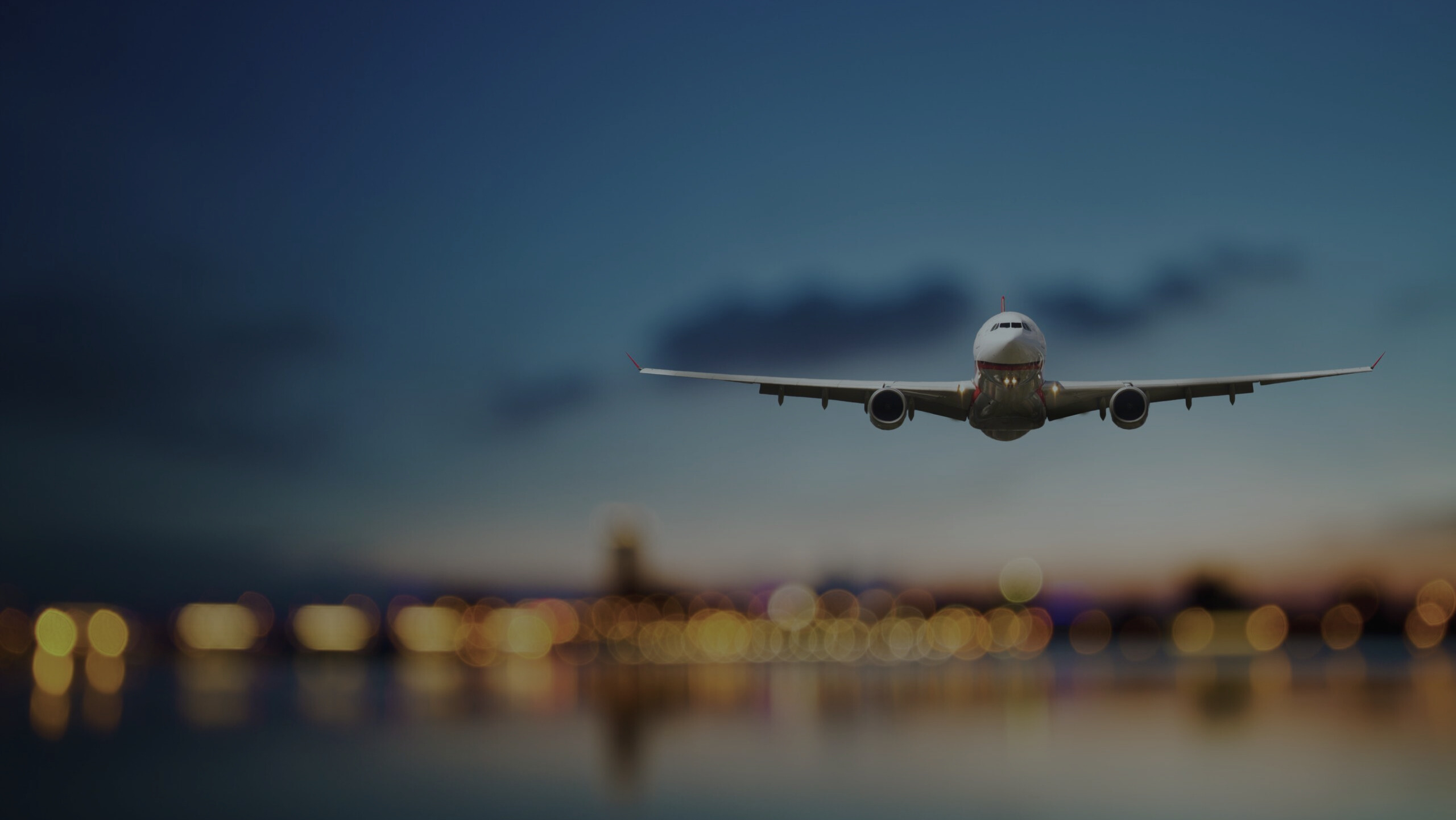Aviation and Plane Crash Statistics
Request Free ConsultationIn under two weeks in 2025, three plane crashes occurred in the United States, resulting in 78 fatalities, it is still accurate to say that plane travel is among the safest modes of transportation. However, when aviation accidents do happen, the results are often catastrophic. There are no such things as minor airplane collisions or crash landings, these occurrences are devastating, life-altering events. Aviation accident rates have gone down in recent years, but the growing popularity of private jet travel and helicopter flights may soon reverse that trend.
In the United States, the National Transportation Safety Board (NTSB) tracks aviation accident statistics and investigates aviation disasters.
In 2007, the National Transportation Safety Board estimated a total of nearly 24 million flight hours. Of these 24 million hours, 6.84 of every 100,000 flight hours yielded an airplane crash, and 1.19 of every 100,000 yielded a fatal crash. This is down from an all-time high of 9.08 accidents per 100,000 hours in 1994. These numbers are higher for private flights, but private flights are much harder to document due to lax government regulation and non-reporting. Private plane crashes have been on the decline since the 1980s, but user error and insufficient training still contributes to many more accidents than are necessary each year.
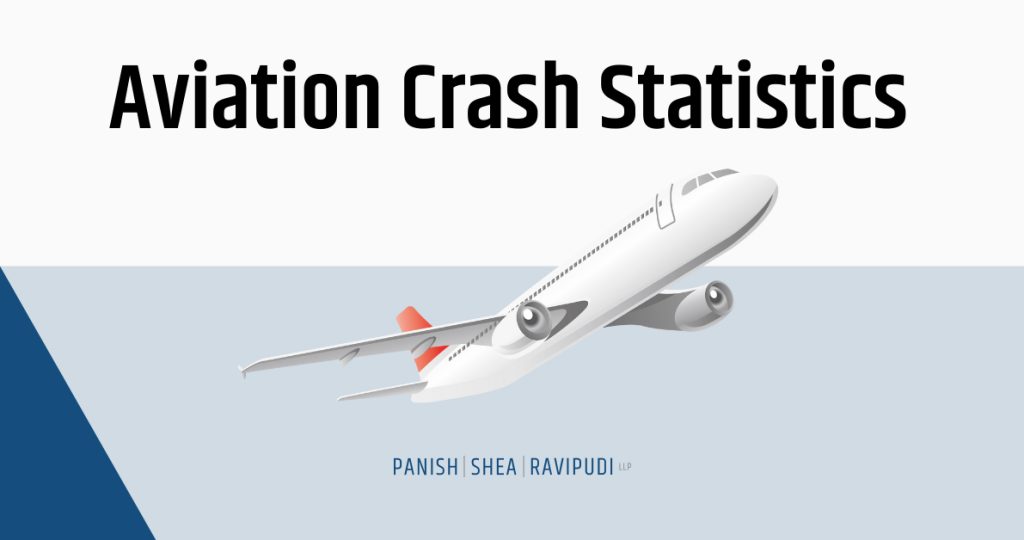
“Statistics show that up to 80 percent of all aviation accidents can be attributed to human error.”
Statistics show that up to 80 percent of all aviation accidents can be attributed to human error. The most dangerous times include takeoff and landing and the time periods before and after these events. Pilot error is thought to account for 53% of aircraft accidents, with mechanical failure (21%) and weather conditions (11%) following behind.
Even in the best training situations, where flight crews undertake comprehensive simulator-based training, human beings tend to revert to previous habitual behaviors. Training helps, but it takes people time to develop muscle memory which can result in catastrophic unintended consequences, particularly when flying a highly maneuverable aircraft.
The NTSB database, which has records of every reportable accident since 2008, shows over 13 thousand accidents with at least one issue pertaining to personnel. All these accidents include over 20 thousand findings related to personnel, with an average of 1.54 per accident.
On the other hand, its important to note that other factors are always in play when pilot error occurs. The aircraft, environmental issues, and organizational issues are a few examples.
How Safe is Air Travel?
Compare it to other major forms of transportation – with 0.04 deaths per 100 million miles traveled, train travel is much more dangerous than airplanes’ 0.01 deaths per 100 million miles. However, air travel is only as safe as the operator, the equipment, and the training procedures that underlie the flight itself. Without stringent aviation safety training and controls, air travel is unsafe for private and commercial passengers.
2025 Commercial Airplane Crashes: (Up To Date)
- January:
An Airbus A321-200 operating as Air Busan Flight 391, bound for Hong Kong from Busan, caught fire just before takeoff at Gimhae International Airport. All 176 passengers and crew survived, though seven sustained injuries.
A Beechcraft 1900 operated by Light Air Services, transporting oil workers, crashed shortly after departing from GPOC Unity Airstrip in South Sudan. Of the 21 people onboard, only one survived.
During the 2025 Potomac River mid-air collision, American Eagle Flight 5342, a Bombardier CRJ700 operated by PSA Airlines, collided with a US Army Sikorsky UH-60L helicopter over the Potomac River. The accident resulted in the deaths of all 64 people on the CRJ700 and all three aboard the UH-60L.
Med Jets Flight 056, a Learjet 55 operated by Jet Rescue Air Ambulance, crashed in Philadelphia’s Castor Gardens neighborhood shortly after takeoff. There were no survivors.
- February:
Bering Air Flight 445, a Cessna 208B Grand Caravan en route from Unalakleet to Nome, Alaska, vanished over Norton Sound. The wreckage was found the next day, confirming the deaths of all 10 onboard.
Delta Connection Flight 4819, a Bombardier CRJ-900, crash-landed at Toronto Pearson International Airport. While all 76 passengers and four crew members survived, 18 sustained injuries.
- March:
Lanhsa Flight 018, a British Aerospace Jetstream 32, crashed into the sea after overrunning the runway during takeoff from Roatán Airport. Thirteen of the 18 people on board lost their lives.
A Trident Aviation DHC-5 cargo plane crashed in a field near Mogadishu, Somalia, following a technical failure, resulting in the deaths of all five people on board.
2024 Commercial Airplane Crashes:
- January:
The 2024 Haneda Airport runway collision involved Japan Airlines Flight 516, an Airbus A350 from New Chitose Airport, colliding with a Japan Coast Guard De Havilland Canada Dash 8 aircraft during landing. While all 379 occupants of the Japan Airlines flight were evacuated safely, tragically, five of the six occupants aboard the Coast Guard aircraft lost their lives. Both aircraft were destroyed in the incident, marking the first hull loss of an Airbus A350. The destroyed DHC-8 was set to provide support in response to the Noto earthquake the previous day.
Alaska Airlines Flight 1282, a Boeing 737 MAX 9 departing from Portland International Airport, experienced uncontrolled decompression when a plug covering an unused exit door blew out. Despite the harrowing incident, the aircraft made a safe return to Portland with all 177 passengers and crew surviving. Fortunately, nobody was seated next to the blown-out door plug, and only three injuries were reported onboard. Various belongings, including an iPhone, fell from the aircraft, with the owner later reclaiming their undamaged phone.
A Jetways Airlines Fokker 50 crashed during a humanitarian aid flight from Mogadishu to Ceel Barde, Somalia. The aircraft ran off the runway upon arrival at its destination, striking a house and resulting in the loss of one of the four occupants.
A Northwestern Air British Aerospace Jetstream crashed shortly after takeoff while transporting mine workers from Fort Smith, Northwest Territories, to the Diavik Diamond Mine in Northwest Territories, Canada. Tragically, six of the seven passengers and crew lost their lives as the aircraft made impact with the ground 500 meters (1600 feet) from the end of the runway.
- February:
Air Serbia Flight 324, operated by Marathon Airlines using an Embraer 195, hit the landing lights during takeoff at Belgrade Nikola Tesla Airport. The aircraft continued to fly for another hour before making an emergency landing back at the same airport, despite sustaining a large hole in its fuselage. Remarkably, all 111 occupants on board survived without injury.
- March:
In the 2024 Nairobi mid-air collision, Safarilink Aviation Flight 53, a De Havilland Canada Dash 8, collided with a Cessna 172. The collision resulted in the Cessna 172 crashing and killing both of its occupants, while the Dash 8 managed to land safely.
LATAM Airlines Flight 800, a Boeing 787-9 traveling from Sydney to Auckland, experienced an in-flight upset that resulted in injuries to 50 passengers. Despite the incident, the flight landed safely at Auckland Airport.
In the 2024 Malakal Airport collision, a Safe Air Company Boeing 727-200 on a cargo flight from Juba Airport undershot the runway and collided with an MD-82 while attempting to land at Malakal Airport, South Sudan. All seven crew members on board survived, with one sustaining injuries.
- May:
During Singapore Airlines Flight 321 from London-Heathrow to Singapore, carrying 229 people, the Boeing 777-300ER encountered severe turbulence, resulting in one passenger’s death and injuring 30 others. The plane made an emergency landing in Bangkok.
- July:
Gazpromavia Flight 9608, a Sukhoi Superjet 100, was on a ferry flight from Lukhovitsy to Moscow when it crashed during an emergency landing attempt near Moscow. Tragically, all three crew members lost their lives in the accident.
A Saurya Airlines Bombardier CRJ-200ER crashed shortly after departing from Kathmandu Tribhuvan Airport on its way to Pokhara International Airport, resulting in the deaths of 18 of the 19 people on board.
Plane Crashes That Have Taken Place in 2023:
In 2023, commercial aviation achieved unprecedented safety levels, surpassing all previous years. As noted by a prominent air safety expert, the year marked a historic milestone with the lowest number of accidents and fatalities recorded.
- January:
Yeti Airlines Flight 691: an ATR 72-500 aircraft operating a domestic flight from Tribhuvan International Airport to Pokhara International Airport in Nepal crashed into the gorge of the Seti Gandaki River, resulting in the loss of all 72 individuals on board.
- February:
Coulson Aviation crash: a Boeing 737-300 aircraft owned by Coulson Aviation and serving as an air tanker, experienced a crash at Fitzgerald River National Park in the Great Southern Region of Western Australia while the aircraft was engaged in firefighting operations to combat multiple fires. Fortunately, both occupants on board managed to survive the crash, only sustaining minor injuries.
- June:
A SAM Air Cessna Grand Caravan crashed on a domestic flight in Papua, Indonesia, resulting in the fatalities of all 4 passengers and 2 crew members.
- July:
A Halla Airlines Embraer EMB 120 Brasilia crashed during landing at Aden Adde International Airport in Mogadishu, Somalia. Fortunately, all 34 occupants survived the incident, with 2 passengers sustaining minor injuries.
- September:
Ural Airlines Flight 1383, an Airbus A320 flying from Sochi to Omsk in Russia, executed an emergency landing in a cornfield due to hydraulic issues. Miraculously, all 165 passengers and crew on board escaped unharmed.
A Manaus Aerotaxi Embraer Bandeirante crashed into an embankment while performing a go-around approach to Barcelos Airport in Brazil, resulting in the tragic loss of all 14 occupants.
- October:
Alaska Airlines Flight 2059, operated by Horizon Air, diverted to Portland after an off-duty pilot attempted to shut off both engines mid-flight. The pilot was apprehended upon landing, and there were no injuries reported.
The 2023 Rio Branco Cessna Grand Caravan crash involved a Cessna 208B Caravan operated by ART Táxi Aéreo, which tragically crashed and exploded shortly after takeoff from Rio Branco International Airport in Brazil, claiming the lives of all 12 individuals on board.
How Many Plane Crashes Took Place in 2022?
According to the latest released report from the International Air Transport Association (IATA), there were 39 total aviation accidents in 2022.
Here are some of the prominent accidents we’d like to highlight:
- March:
A China Eastern Airlines Boeing 737-800 plane crashes in the mountains of Guangxi near Guangzhou, China, leading to the tragic loss of all 133 people on board.
- April:
A DHL Aviation Boeing 757-200 freighter crashes near the runway at Juan Santamaria Airport in San Juan, Costa Rica. All crew members managed to escape with minor injuries.
- May:
The crash of a Tibet Airlines Airbus A319 at Chongqing Jiangbei International Airport while taking off. The plane caught on fire but luckily all people on board have survived.
A Tara Air DHC-6 Twin Otter crashes in the Mustang region of Nepal. Unfortunately, all 22 people on board were killed.
- June:
A Red Air McDonnell Douglas MD-82 crash-lands and catches on fire while landing at Miami international airport. All the people on board survived with 3 occupants being hospitalized for minor injuries.
- July:
The tragic crash of Meridian Flight 3032 occurred near Kavala, Greece, resulting in the loss of all eight individuals on board. The aircraft, an Antonov An-12, was carrying a cargo of weapons and ammunition from Niš, Serbia, destined for Dhaka, Bangladesh.
Jubba Airways Crash 2022: A Fokker 50 aircraft operated by the airline crashed and overturned upon landing in Mogadishu, Somalia. Out of the 36 individuals on board, 16 sustained injuries.
- September:
Tragically, in the Mutiny Bay plane crash of 2022, a DHC-3 Turbine Otter aircraft transporting tourists from Friday Harbor Seaplane Base in Washington to Renton Municipal Airport experienced a sudden nosedive into the sea. Regrettably, all ten individuals on board lost their lives in the incident.
- October:
Korean Air Flight 631, an Airbus A330-300 aircraft departing from Seoul-Incheon International Airport, an unfortunate incident occurred when the plane overshot the runway during its third landing attempt at Mactan-Cebu International Airport in the Philippines. The adverse weather conditions were identified as the contributing factor. Thankfully, none of the 173 passengers and crew members sustained any injuries. But the aircraft itself suffered irreparable damage.
- November:
Precision Air Flight 494, an ATR 42-500 aircraft operating a domestic flight from Dar es Salaam, crashed into Lake Victoria while attempting to land at Bukoba Airport in Tanzania. Out of the 43 individuals on board, 19 lost their lives in the accident.
LATAM Perú Flight 2213, an Airbus A320neo-271N operated by LATAM Chile, encountered a collision during takeoff from Lima to Juliaca. The aircraft collided with a fire engine that was crossing the runway, resulting in the unfortunate deaths of two firefighters and injury to a third individual. All passengers and crew remained unharmed.
Aviation Crashes and Injuries Statistics
Our team worked on gathering data on all aviation crashes from 1982 until the latest available data for 2019. We sorted the total injuries into 3 tiers: fatal injuries, serious injuries, and minor injuries. Here’s a chart that visualizes all the aviation crashes and injuries we’ve analyzed for this study:
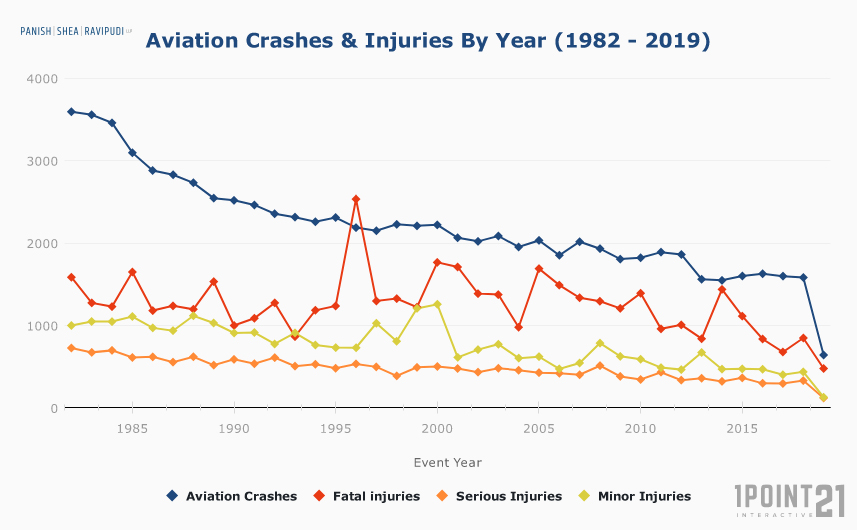
Additionally, here’s the full table of data for all aviation crashes that took place between 1982 and 2019.
Please note that the data for 2019 is incomplete which explains the sharp decline in crashes.
| Year | Number of Crashes | Fatal Injuries | Serious Injuries | Minor Injuries |
|---|---|---|---|---|
| 1982 | 3593 | 1585 | 727 | 998 |
| 1983 | 3556 | 1273 | 673 | 1048 |
| 1984 | 3457 | 1229 | 697 | 1047 |
| 1985 | 3096 | 1648 | 612 | 1108 |
| 1986 | 2880 | 1180 | 619 | 970 |
| 1987 | 2828 | 1237 | 554 | 936 |
| 1988 | 2730 | 1195 | 620 | 1117 |
| 1989 | 2544 | 1532 | 518 | 1029 |
| 1990 | 2518 | 999 | 589 | 908 |
| 1991 | 2462 | 1087 | 535 | 913 |
| 1992 | 2355 | 1273 | 609 | 775 |
| 1993 | 2313 | 865 | 505 | 910 |
| 1994 | 2257 | 1183 | 529 | 763 |
| 1995 | 2309 | 1236 | 480 | 731 |
| 1996 | 2187 | 2533 | 532 | 729 |
| 1997 | 2148 | 1296 | 497 | 1026 |
| 1998 | 2226 | 1325 | 388 | 807 |
| 1999 | 2209 | 1221 | 491 | 1206 |
| 2000 | 2220 | 1765 | 501 | 1256 |
| 2001 | 2063 | 1709 | 478 | 612 |
| 2002 | 2020 | 1386 | 432 | 706 |
| 2003 | 2085 | 1374 | 480 | 772 |
| 2004 | 1952 | 978 | 457 | 603 |
| 2005 | 2031 | 1689 | 426 | 620 |
| 2006 | 1851 | 1489 | 420 | 473 |
| 2007 | 2016 | 1335 | 402 | 543 |
| 2008 | 1931 | 1293 | 511 | 786 |
| 2009 | 1805 | 1207 | 381 | 625 |
| 2010 | 1821 | 1390 | 343 | 589 |
| 2011 | 1889 | 959 | 432 | 488 |
| 2012 | 1861 | 1007 | 336 | 464 |
| 2013 | 1561 | 839 | 358 | 671 |
| 2014 | 1547 | 1438 | 321 | 469 |
| 2015 | 1600 | 1112 | 364 | 473 |
| 2016 | 1628 | 835 | 297 | 468 |
| 2017 | 1597 | 677 | 295 | 401 |
| 2018 | 1581 | 847 | 331 | 437 |
| 2019 | 640 | 477 | 120 | 129 |
| Total | 83374 | 47719 | 17862 | 28607 |
Nearly Half of All Aviation Crashes Happen During Landing or Takeoff
One fact becomes clear after looking at historic aviation crash data and focusing on the phase of flight during which the crash took place: Landing and Takeoff are the most complex phases of flight for any airplane. Nearly half of all the aviation crashes we analyzed covering the period 1983 – 2019 took place during either landing or take off procedures. These phases place a heavy load on airline crews and ground teams as well.
The tough combination of constant airplane configuration changes, having to navigate the plane, communicating with Air Traffic Control, and keeping an eye on ever-changing weather conditions increases the potential for unanticipated events which sometimes leads to a crash.
This following chart visualizes the disparity in aviation crashes when looking at the phase of flight in which the accident took place:

General Aviation Aircraft Involved in 78% of Crashes
Furthermore, our team analyzed the types of flights involved in the most crashes and found that general aviation aircraft were involved in almost 78% of all crashes. General aviation aircraft include all civilian flights except for passenger or cargo transport that is scheduled by an airline company.
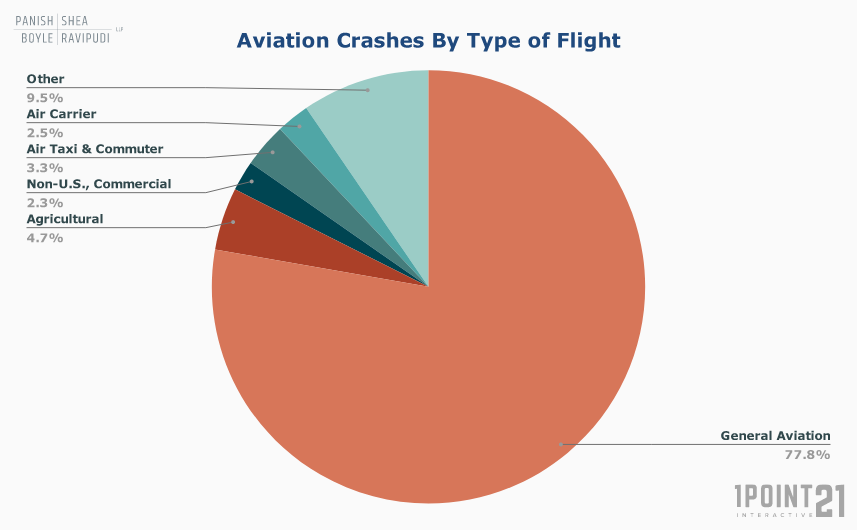
One of the main reasons why general aviation planes are involved in so many crashes is that there are many more of them flying than scheduled commercial flights.
However, if we look at the percentage of fatal accidents by the type of flight, we see that general aviation was involved in almost 45%, while non-US commercial and other flights share almost half of crashes that involved a fatality.
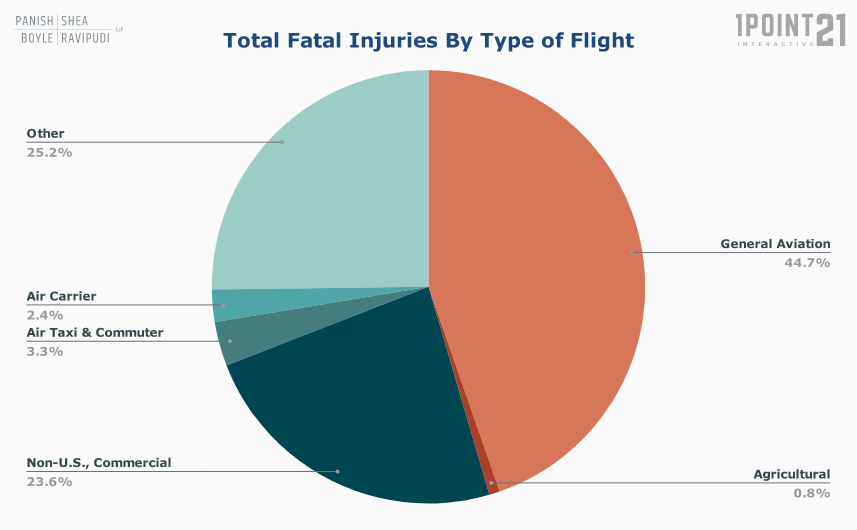
It’s Tough to Investigate an Aviation Accident
No matter what the aviation accident statistics, one fact remains clear – investigating an aviation accident is time-consuming and complex. It’s also necessary when an aviation-related lawsuit is filed. If you have been injured in an airplane accident or your loved one has lost his or her life, don’t delay. Your time to file could be limited. Call an experienced, reputable law firm for the help you deserve. Panish | Shea | Ravipudi LLP represents personal injury victims nationwide. We have what it takes to fight for you in court and reconstruct what happened to you in the air. Call today for a free case consultation.
